How to create a WooCommerce events page (with or without an events plugin)
If you use your WordPress website to sell upcoming events, you’ll need an effective way to display them. While you can use a dedicated WooCommerce events plugin, these can be complex and weigh down your site – which is the last thing you want. Keep reading to learn the pros and cons of both options, and how to set them up.
Are you looking to create an events page for your WooCommerce store but not sure where to start? Look no further! In this comprehensive guide, I'll walk you through the process of creating a dynamic and engaging events page, with or without using an events plugin.
Surprisingly, there are several ways to add events to WooCommerce. Some involve using a fully featured events plugin, and others are simpler alternatives which achieve a similar result. You can either:
- Add a date picker to a WooCommerce product with the WooCommerce Product Options plugin, or;
- Use a traditional WooCommerce events plugin like Events Calendar with the Tickets add-on.
Whichever method you use, you can then list your events in a searchable table to help people find them more easily. The best way to do this is by installing the WooCommerce Product Table plugin.
In this post, I'm going to tell you all about both ways to create a WooCommerce events page. I'll also show you how to list your events in a table so that more people will find and book your events.
Let's get started!
Method 1: Add an event date field to your WooCommerce products
The easiest way to convert any WooCommerce product into an event is to add a simple date field to it. The WooCommerce Product Options plugin is perfect for this because it lets you add a wide range of extra fields to your products.
You can add a date field where customers choose a date and time from a calendar. In addition, you can add lots of other event-related fields, for example to collect extra information from attendees.
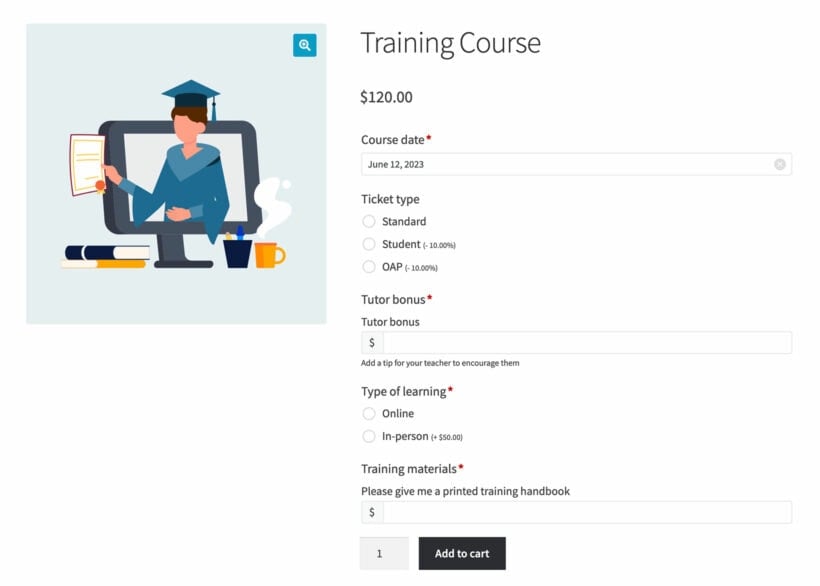
Using this method to create a WooCommerce events page is much simpler than using a dedicated events plugin. However, it's surprisingly powerful because you get everything you need to manage and sell events. For example, you can choose which dates and time slots are available. You can choose how far in advance people can book an event.
While the simple date picker field is missing some options such as setting a maximum number of attendees, it's ideal if you want a simple solution.
How to add a date field to a product
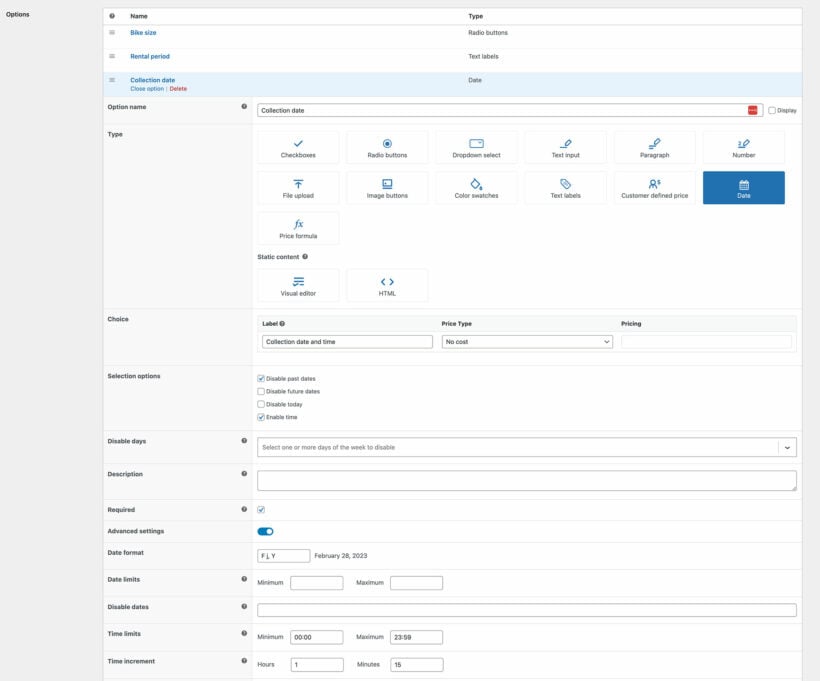
- First, create the products that you will be adding the event date field to (Products → Add New).
- Next, install the WooCommerce Product Options plugin.
- Go to Products → Product Options in the WordPress Dashboard.
- Create a new options group and give it a name that you will remember. Select the product(s) that you want the date field to appear on, or leave this field blank to add it to all products.
- Next, click 'Add Option'. Choose the 'Date' option type.
- Fill in all the options for your event date field.
- Finally, visit the product page. You will see the event date field above the add to cart button.
Now go back and add any other fields that you need for your event pages. This is an excellent way to collect information about the people who will be attending your events. You can also sell extras, such as training handbooks or lunch.
Method 2: Use a WooCommerce events plugin
As we have seen, adding date calendar fields to your event products can be surprisingly sophisticated. However, if you want extra features such as managing availability and full ticket management, then you'll need a WooCommerce events plugin.
The Events Calendar is widely regarded as the best plugin to add and manage events in WooCommerce. This is thanks to its robust features, user-friendly interface, and seamless integration with the WooCommerce platform. The plugin has been designed with both simplicity and flexibility in mind, making it suitable for both novice and advanced users. When paired with the Event Tickets add-on, you can not only create and display events but also sell tickets for those events directly through your WooCommerce store.
Features
The main features of The Events Calendar include:
- Easy event creation: With a simple and intuitive interface, creating events becomes a breeze. Add details such as event name, date, time, location, description, and organizer information.
- Calendar view and list view: Display your events in a visually appealing calendar view or a straightforward list view, depending on your preferences and website design. These are ok if you just have a few events, but I recommend using Events Calendar with the WooCommerce Product Table plugin for a more structured and searchable display. We'll cover this later in this article.
- Responsive design: The Events Calendar is fully responsive, ensuring that your events page looks great on all devices, including desktop, tablet, and mobile.
- Customizable templates: Customize the look and feel of your individual events pages using pre-built templates, or create your own with custom CSS.
- Integration with Google Maps: Easily add location information to your events, and automatically display a Google Maps view for easy navigation.
- Recurring events: Schedule events that occur regularly, such as weekly or monthly, without having to create each event individually.
- Import and export functionality: Import events from other sources or export your events for use in other platforms.
- Event Tickets add-on: This powerful add-on allows you to sell tickets for your events, manage attendees, and even offer multiple ticket types (e.g., general admission, VIP, etc.).
Using Events Calendar to create WooCommerce events
- Install and activate The Events Calendar plugin: Navigate to the 'Plugins' section in your WordPress dashboard. Click 'Add New', search for 'The Events Calendar', and then install and activate the plugin.
- Install and activate the Event Tickets add-on: Similarly, search for 'Event Tickets' in the 'Add New' plugin section, then install and activate the plugin.
- Now you need to purchase and install the premium version of Event Tickets. This is what adds the WooCommerce integration for selling access to your events.
- Configure plugin settings: Go to Events → Settings in your WordPress dashboard to configure the plugin settings, such as your preferred calendar view, timezone, currency, and more.
- Create an event: Click on Events → Add New to start creating your first event. Fill in the required event details, such as title, date, time, location, and description.
- Add tickets to your event: With the Event Tickets add-on installed, you can add tickets to your events by scrolling down to the 'Tickets' section on the event editing page. Set ticket prices, quantity, and any other relevant details. This creates a WooCommerce product, which is your 'ticket'.
As you can see, Events Calendar requires a lot more setup than simply using WooCommerce Product Options to add an event date field to your products. However, this is the best option if you need the extra features that come with a dedicated WooCommerce events plugin.
Why you need a better way to display WooCommerce events on your website
A WordPress website is a fantastic way to showcase events and gather an audience for them. You can promote them to existing customers and new visitors, provide all the information they’ll need, and let them buy tickets or make reservations online.
Whichever of the above methods you use to turn WooCommerce products into bookable events, they involve setting up a dedicated page (i.e. a product) for each event. This is the best way to add and manage events. However, it does mean that visitors will need to navigate through a lot of different pages to see all your WooCommerce events, which isn’t ideal. The default WooCommerce store layout simply isn't appropriate for selling courses or events.
The solution to this problem is to create a searchable table-based WooCommerce events page like this:
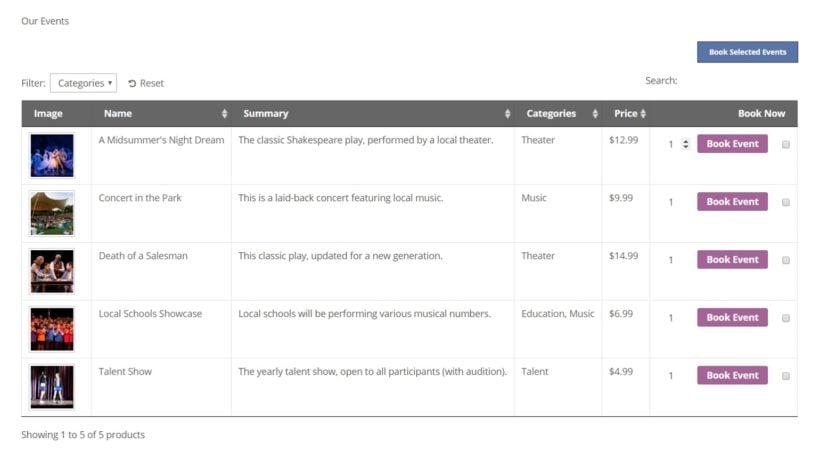
Why list events in a WooCommerce table?
There are lots of reasons why a product table is ideal for creating a WooCommerce events page:
- You can include the essential information about each event, providing visitors with what they need to make a decision without overwhelming them with details.
- Customers can quickly search and filter the list of events to find what they're looking for.
- Plus, they’ll be able to make comparisons easily, choose the number of places they want to book, and even purchase tickets to several events at once.
This plugin lets you create a product table organizing all your WooCommerce events into one place. You can include whatever information you like about each event. It’s a fantastic way to peak your visitors’ interest and encourage them to sign up for more events.
How to create a WooCommerce events page
Putting together a WooCommerce events table is simple. Before you do this, make sure you have created your events using one of the methods described above. WooCommerce Product Table works with either method.
Follow the simple steps below to display your WooCommerce events effectively. The end result will look similar to our events list demo page.
Step 1: Install the WooCommerce Product Table plugin
Naturally, the first thing you’ll need to do is get your hands on WooCommerce Product Table.
When you purchase the plugin, you’ll be provided with a zip folder containing all its files. Download this, then install the plugin on your WordPress site via Plugins → Add New.
Next, navigate to 'Products', and click on 'Product Tables' and then 'Add New'. This will launch the table builder, which you'll need for step 2.
Step 2: Create your WooCommerce events table
Go through each step of the table builder to create your WooCommerce events list:
- First, select the option to add the table to a page using a block or shortcode.

- Next, choose which products to include in the table. For example, if you use WooCommerce to sell products that aren't events then you should just select the event categories here. The rest of your store will be unaffected.
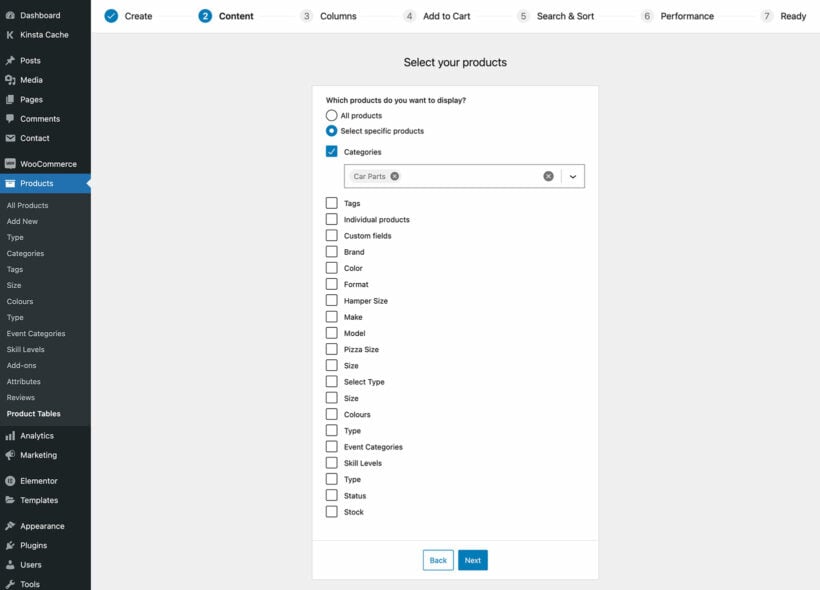
- Choose which columns of information about your WooCommerce events to include in the table. Try to strike a balance between providing all the necessary information, and not overwhelming your visitors. For an events table, we’d recommend the following columns at a minimum: image, name, summary, categories, price, and buy.
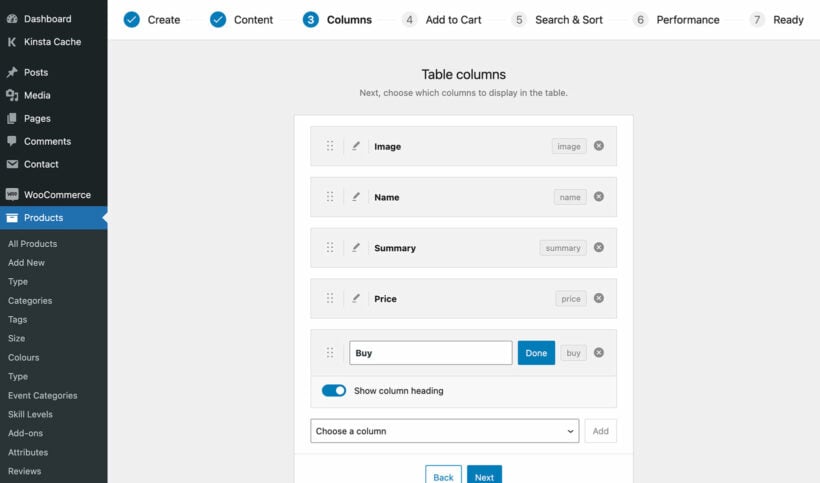
- You may want to rename some of the labels in your events table. For instance, instead of using Buy above the final column, you could use something more events-specific, such as Book Now. To do that, click on the pencil icon for each column and rename it as needed.
- On the 'Add to cart' page, you’ll definitely want to check the Quantity selectors box. That way, if people want to bring along friends or family to the event, they can reserve multiple places at once.
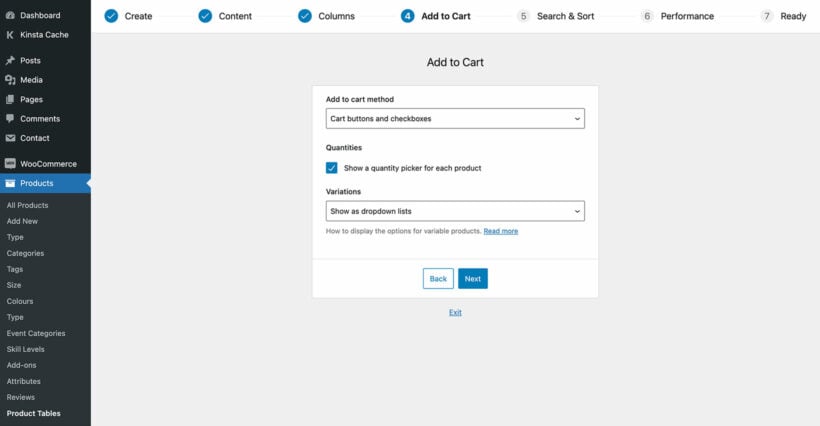
- If you choose Button and checkbox for the 'Add to cart method', then customers will be able to purchase tickets for more than one event at a time, and add everything to their cart with a single click. This is a smart way to streamline their experience.
- After that, take a look at the Filter dropdowns field. You may want to add filters for data such as product categories, tags or attributes. This will place one or more dropdown menus above your WooCommerce events table. If you offer more than a few events, this makes the events list much more user-friendly.
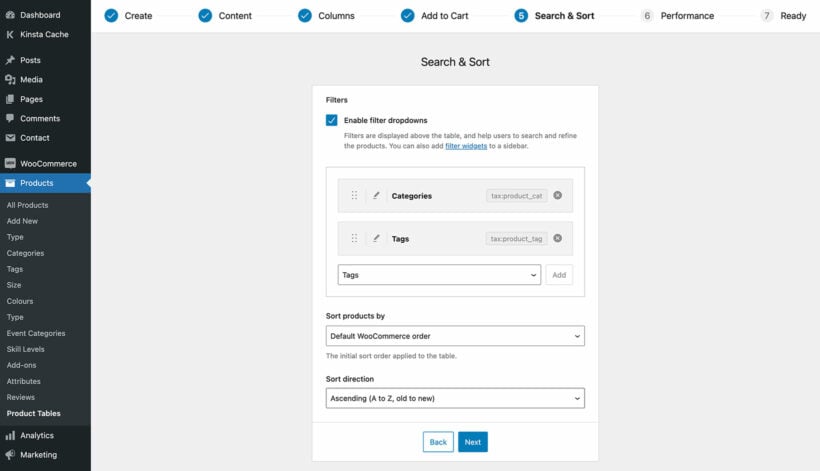
Step 3: Change the add to cart button text
By default, WooCommerce displays buy buttons with the text "Add to cart". I don't think that's really suitable for selling events in WooCommerce. As a result, you should use the option at Products → Product Tables → Settings to change this to something more appropriate like "Book Now".
Step 4: Create your WooCommerce events page
Now, it’s time to create the page where your WooCommerce events will be displayed. To do that, just navigate to Pages → Add New.
If you're using the WordPress block editor then insert a 'Product Table' block and select your table. Otherwise, get the shortcode from Products → Product Tables and add the table that way.
After that, view the page to see the WooCommerce events plugin in action:
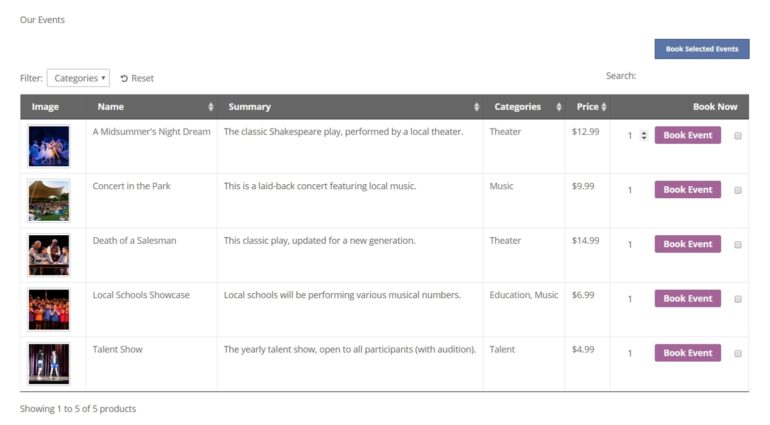
Or if you decided to keep things simple then it might look more like this:
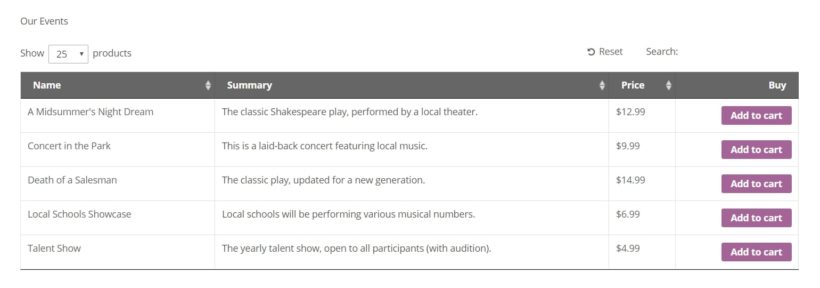
Note: If you're using WooCommerce Product Table with the Events Calendar plugin, then these instructions will list your tickets in a table - not the actual events. If you want to list the events instead of the tickets then we have another tutorial on how to do that.
Step 4 (optional) - Add quick view to the list of events

So far, I've shown you how to list events in WooCommerce with all the information and purchase options in a table. If you want to display extra information that won't fit neatly into a table option, then you can send customers to the single product page for each event. However, this loses momentum and makes the customer less likely to book multiple events. It's better to keep them on a single page while they're choosing their events.
The solution is to add quick view buttons to your list of events. You can do this with the WooCommerce Quick View Pro plugin, which is designed to work with WooCommerce Product Table. This adds lots of flexibility to your WooCommerce event listings. For example:
- If you want to show multiple images from previous events, you can show the full product image gallery in a quick view lightbox. This really brings the event to life, making people more likely to book a place. There are 2 options for how to display the image gallery (thumbnails or bullet navigation).
- Customers can buy product variations directly from the quick view popup. For example, they can choose different ticket options for each event and add them to the cart.
- You can show extra information such as the event short description and price.
What types of event can I sell in WooCommerce?
The fantastic thing about this method is that you can use it to sell literally any type of events. For example:
- Live in-person events Admissions tickets, live music or comedy events, charity events, concerts, conferences, dating events, festivals, meet-ups, performances
- Online events Livestreams, live coaching, online conferences, webinars.
- Courses Bootcamps, classes, crash courses, test preparation or interview training, training courses, webinars.
Now let’s see what a lightweight list of WooCommerce events looks like in action.
Case study: Using WooCommerce to sell event tickets
To get a taste for what you can accomplish using the WooCommerce Product Table plugin, check out Weave The Ring:

Here, you’ll find a well-designed WooCommerce events product table. Each event is listed on its own row, along with key details such as its description, category, price, and even a featured image.
Customers can scroll through the table to see all the events on offer, or use the filter at the top to sort the table by a specific category. This helps them find what they’re looking for more quickly. They can also click on each event’s title to visit its dedicated page, in case they want more information.
When a visitor knows what event they want to see, they can use the quantity selector to choose how many people will be attending. Then, they can click on the handy Add to cart button to make their purchase. If they’re interested in multiple events, they can even select everything at once using the checkboxes under the Buy column, then use the Add Selected to Cart button at the top of the table.
You may want to visit this site yourself, in order to try out the table and get a better sense for its functionality. Then, come back here to learn how to create your own WooCommerce events page!
Case study - Selling WooCommerce events imported from Moodle

Tallahassee Christian College and Training Center use WooCommerce to register for their higher education and training courses. They use the free Edwiser Bridge plugin to integrate their WordPress WooCommerce website with Moodle, automatically importing their courses as WooCommerce products.
They use WooCommerce Product Table to list the courses in a table layout. Students can quickly filter the table by category or tag, and click through to the single product page to register.
Bonus: How to sell entry tickets in WooCommerce
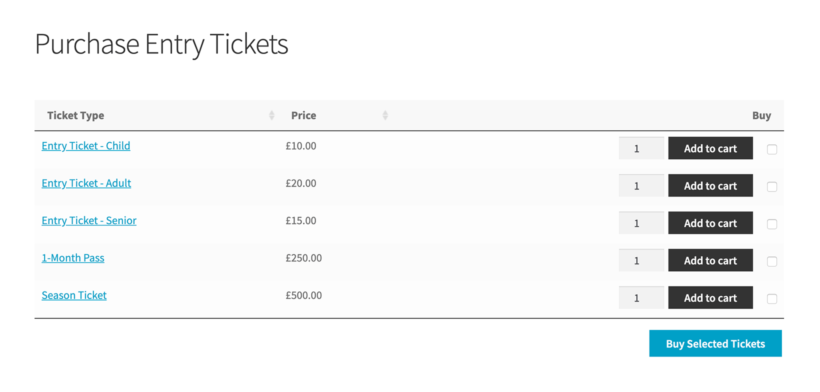
You can use the techniques discussed in this tutorial to sell entry tickets to a range of locations including museums, art galleries, tourist attractions, or events. Again, you only need WooCommerce and WooCommerce Product Table, and don't need an events plugin.
Simply add each type of entrance ticket as a product (with variations, if required) and list them using WooCommerce Product Table. Activate user-friendly features such as add to cart checkboxes so that visitors can select multiple ticket types and add them to the cart together. For example, a parent might select 2 child tickets and 2 adult tickets before purchasing them all together.
Bonus: Set the default ticket quantity to zero
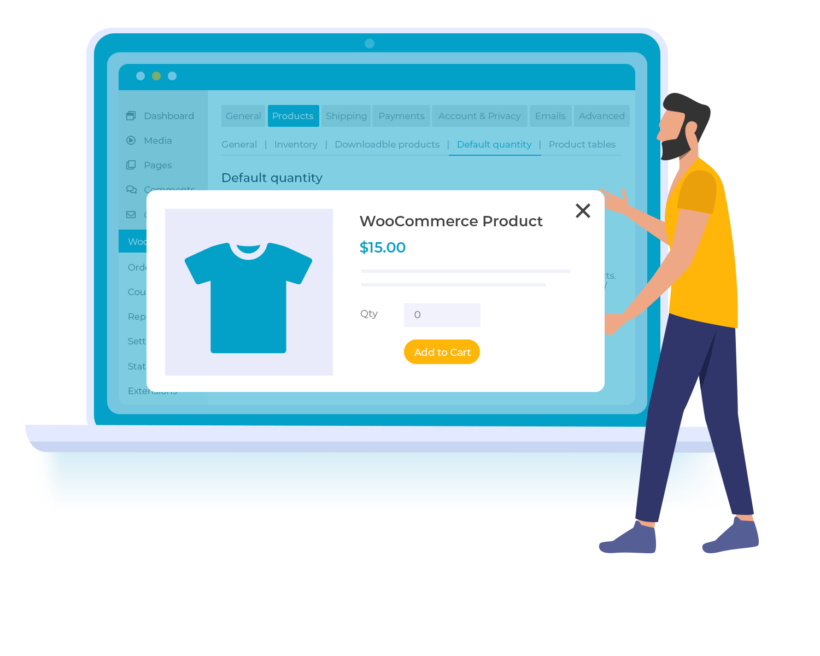
In WooCommerce, the default quantity for buying products is always 1. This applies to any type of products, including events and entrance tickets. However, a default quantity of 0 is actually more appropriate when selling tickets, seats for theatre shows, or places on courses or events.
You can easily change the default quantity to zero by installing the WooCommerce Quantity Manager plugin. That way, shoppers can change the required quantity for each ticket to any number they choose before adding them to the cart.
Where to get the plugins
In conclusion, creating a dynamic and engaging events page for your WooCommerce store doesn't have to be a daunting task. This guide has outlined two primary methods to achieve this goal:
- Using the WooCommerce Product Options plugin to add a date picker field to your products, or;
- Opting for a traditional WooCommerce events plugin like Events Calendar with the Tickets add-on.
To further enhance your events page, you can use the WooCommerce Product Table plugin for a searchable and user-friendly event listing experience.
By carefully considering the pros and cons of each option and assessing your specific needs, you can make an informed decision that best suits your website. Whichever method you choose, remember that the ultimate goal is to create an events page that is both visually appealing and functional. It must make it easy for your customers to discover and book your events. With the right tools and strategies, your WooCommerce events page can become a valuable asset for promoting your upcoming events and driving sales.
Do you have any questions about how to set up the perfect WooCommerce events page? Ask away in the comments section below!
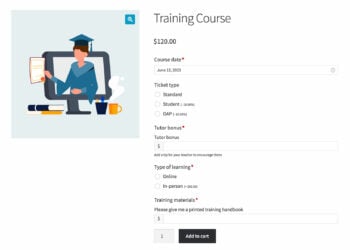

7 Comments
We have used the Events Calendar and Events Tickets... however we've had several issues that with the Events Tickets Plus plugin from that company. We are looking to move away from using it, especially now with the new High Performance Order Storage HPOS woocommerce is moving to. we're in the middle of gettign support for one site now that is in peak sales season and losing sales due to a bug with Events Tickets Plus.
Barn2Media plugins have been solid. Was doing a Google search on alternative live events type of products and came across this blog post. Thanks.
Hi, John. Thanks for your comments and the kind words for our plugins. I'm glad you found our tutorial via Google search. All our plugins, such as WooCommerce Product Options and WooCommerce Product Table mentioned here, have been HPOS compatible since last year. You can see exactly when this was declared for each plugin in our Changelogs.
I hope the information here is helpful for your use case. Should you have any questions, you can get in touch via our dedicated Support Center. Cheers.
Hi - We run a lot of culinary workshops. In order to run a session we need a minimum of 10 participants and we can not afford running the event for less. Is there a way to set up registration, and ticket sales to ensure the minimum revenue is met?
Hello David, thank you for your comment! I believe that the functionality you're seeking extends beyond the intended design of WooCommerce Product Options. In this case, I would recommend visiting https://theeventscalendar.com/ for the specific feature you're looking for. I've heard that The Events Calendar has another plugin called the "Event Tickets" that can assist you in setting minimum participant requirements. This add-on may provide the functionality you're looking for, allowing you to manage and enforce minimum participant numbers for events.
See: https://theeventscalendar.com/knowledgebase/k/how-event-tickets-calculates-availability/
I hope this makes sense and helps. If you have any more questions about our plugins, you can get in touch via our Support Center, and we would be delighted to discuss this with you in more detail. Many thanks!
I would like to use your technique for people to register and pay for religious retreats. However, I only want to list upcoming retreats (events). Will this technique using just woocommerce work, or would I need to use The Events Calendar/Event Tickets Plus in conjunction with woocommerce?
Thanks,
Mark
Hi
Talking about events the date is one of the most important things to know and people want to see the upcoming ones first
So I think it makes sense to use the product data table if events are.shown in a chronological order starting from the closest one.
Now the question is:
How are the products /events listed? Do they follow a.chronological order
Thank you!
Hi Alex, the plugin comes with 'Sort by' and 'Sort order' options which let you choose to order the table by date or any other field.